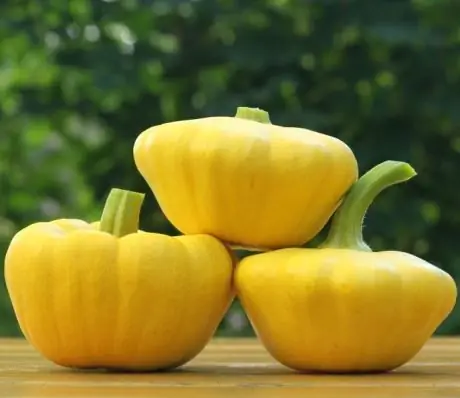- Author Rachel Wainwright [email protected].
- Public 2023-12-15 07:39.
- Last modified 2025-11-02 20:14.
Squash
Squash is a type of hard-barked common pumpkin. Squash is grown for decorative and food purposes. South and Central America is considered his homeland. In France, the squash is called the Jerusalem artichoke.
The ratio of BJU in the product

Source: depositphotos.com How to burn 18 kcal?
| Walking | 5 minutes. |
| Jogging | 2 minutes. |
| Swimming | 2 minutes. |
| A bike | 3 min. |
| Aerobics | 4 minutes |
| Household chores | 6 minutes |
In our country, it is not particularly popular, since it requires considerable effort in cultivation. These vegetables are more moisture-loving and more demanding on growing conditions than squash.
The squash blooms and forms an ovary continuously, until the frost. Fruits form 4-7 days after flowering. Squash fruits are much tastier than squash or pumpkin. Their weight varies from 100 to 800 grams (depending on the age of the vegetable). Most often white vegetables are grown, however, green, orange, yellow and even purple squash are sometimes found in nature. The most useful and tasty are unripe squash, collected at the age of five to six days. It is at this time that their pulp is tender and elastic. Overripe fruits lose their pleasant taste, and their flesh becomes rough and woody. Such squash is used as feed for livestock.
Nutritional value and calorie content of squash
One hundred grams of squash contains 92 g of water, 0.6 g of proteins, 0.1 mg of fat, 5.5 g of carbohydrates (including 4.1 g of mono- and disaccharides), 1.3 g of dietary fiber, 1.0 g of pectins, 0.1 g of organic acids and 0.7 g of ash.
100 g of fruit contains 0.03 mg of vitamin B1, 0.04 mg of vitamin B2, 0.3 mg of niacin, 23 mg of vitamin C, 120 mg of potassium, 13 mg of calcium, 25 mg of magnesium, 13 mg of sodium, 12 mg of phosphorus and 0.4 mg iron.
Patissons are low in calories and contain a large amount of fiber. The calorie content of squash is 19 kcal per 100 g of fruit. Sugars are found in fruits in the form of fructose and glucose, which increases their absorption.
The benefits of squash
Patissons are a valuable product in medical and dietary nutrition. Since these vegetables are 90% water and alkaline compounds, they are best absorbed when consumed with meat or other protein foods. Alkaline compounds improve bile secretion, restore glycogen and support hematopoiesis. Fiber removes excess fats and all toxins from the body. Pectin substances, like jelly, envelop cholesterol and remove excess cholesterol from the body.
That is why squash can be of considerable benefit in diseases of the liver, kidneys, atherosclerosis, dysbiosis, hypertension, peptic ulcer and anemia. In addition, the benefit of squash is a very active diuretic action. In addition, squash has a mild laxative effect. Regular consumption of the fruit helps to remove table salt and fluid from the body. Plus, these vegetables reduce the risk of cancer.
Orange fruits contain the highest amount of lutein. Lutein in the blood neutralizes free radicals and prevents blood clots. In addition, lutein strengthens the immune system and has a beneficial effect on vision.
The seeds of these vegetables are very useful. Edible seed oil is a highly nutritious protein and vitamin product of high quality. 100 ml of oil contains 600 kcal. In addition to oil, seeds contain resins, glycosides and unsaturated fatty acids. Squash seeds rank second in lecithin content (after eggs). It is useful to use them in diseases of the genitourinary system, as well as to restore the functions of the endocrine and nervous systems.
Before use, the seeds should be peeled and ground into powder in a coffee grinder. With edema, it is useful to eat two tablespoons of peeled squash seeds (30 minutes before meals, three times a day).
Squash juice has an unusual taste. It improves the functioning of the digestive system and calms the nervous system.
The use of squash
This vegetable is perfect for cooking, frying, stewing, fermentation. Some culinary experts make sweet, aromatic and tasty jam from squash. Original snacks are made from pickled and salted squash. Cook these vegetables for no more than 15-20 minutes.

Young squash is cooked whole. The pulp is cut from the fruit. These vegetables can be filled with herbs, cheese, minced meat, corn and grilled or in the oven. Vegetables go well with aromatic and hot spices.
The taste of squash stewed in a pan resembles that of asparagus, and pickled vegetables have the taste of porcini mushrooms. Lightly salted vegetables can replace cucumbers.
It is not recommended to use squash for intestinal disorders, as they stimulate intestinal peristalsis.
These vegetables, like cabbage and zucchini, are perfectly stored at temperatures from 0 to + 1 ° C.
Moreover, they are stored much longer than other vegetables. For storage, squash is packed in plastic bags and placed in basements.
YouTube video related to the article:
Found a mistake in the text? Select it and press Ctrl + Enter.






